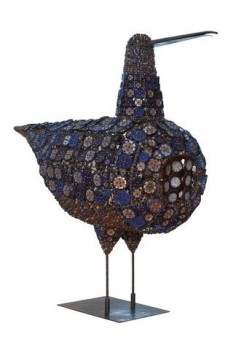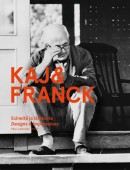Tag: design history
A rare bird from Fancyland
20 August 2013 | Reviews

Bead-covered curlew, 1960. Height ca. 115 cm, Collection Kakkonen. Photo: Niclas Warius
Harri Kalha:
Birger Kaipiainen
Helsinki: Suomalaisen Kirjallisuuden Seura (The Finnish Literature Society), 2013. 249 p., ill.
(Summaries in Swedish and English)
ISBN 978-952-222-457-6
€46, hardback
Ceramics confectioner. Degenerate aristocrat. Ornamental criminal. These epithets can be found in Birger Kaipiainen, a new, full-length study of the ceramic artist by art historian Harri Kalha.
Throughout his artistic career Birger Kaipiainen (1915–1988) worked with forms, subjects and methods that were unfamiliar in the field of traditional ceramics, at least in mid-20th-century Finland, and made use of fantasy and ornament. As a ‘porcelain painter’ he showed little interest in the technical challenges of clay – although in his ceramic creations Kaipiainen explored three-dimensional form, montage, colour, texture and the tactile dimensions of the medium. More…
Päivi Jantunen: Kaj & Franck. Esineitä ja lähikuvia / Designs & Impressions
6 July 2011 | Mini reviews, Reviews
 Kaj & Franck. Esineitä ja lähikuvia. / Designs & Impressions
Kaj & Franck. Esineitä ja lähikuvia. / Designs & Impressions
English translations: Peter Herring and Esa Lehtinen
Helsinki: WSOY, 2011. 166 p., ill.
ISBN 978-951-0-36898-5
€ 42, hardback
This dual-language book showcases the work of one of Finland’s most widely known glass and ceramic designers in his centenary year. The unaffected designs and clean geometric shapes of the tableware designed by Kaj Franck (1911–1989) are well suited to a wide range of cultures. Franck’s guiding principle was to create anonymous, self-evident objects for everyday use. In the 1940s and 1950s, Franck updated tableware to match post-war changes in society; he wanted to get away from the sets of crockery that filled up smaller kitchen cupboards. His designs that emphasised environmental principles and equality were ahead of their time with their ideology of sustainable development. This book portrays Franck’s life and career, which centred on the oldest glassworks in Finland in the community of Nuutajärvi, where he worked from the early 1950s until his death. Interviews with local residents and Franck’s colleagues create a portrait of him as a colourful personality. Ample illustrations provide a cross-section of Franck’s design output. In addition to his mass-produced items, there are photos of Franck’s one-off artistic creations.
Translated by Ruth Urbom
